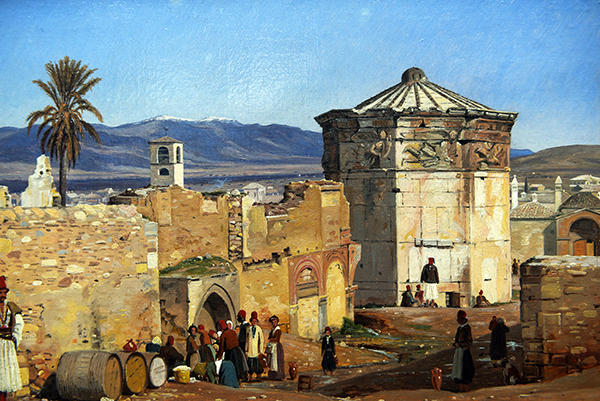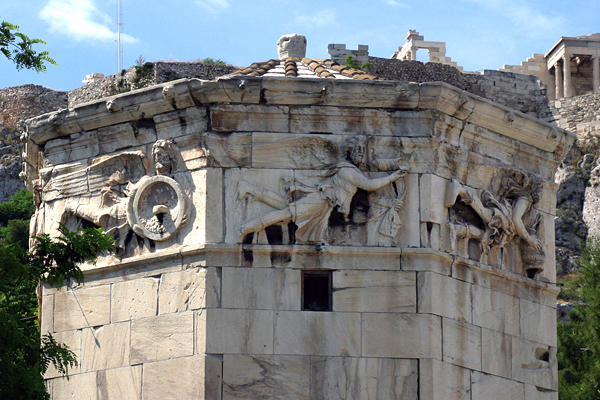
"For Homer and Hesiod were the first to compose Theogonies, and give the gods their epithets, to allot them their several offices and occupations, and describe their forms."
Herodotus, The Histories (II.53)
In Homer, there were only four winds, corresponding to the cardinal points of direction, each with its own characteristics. Boreas, the North Wind, which blew from its home in the mountains of Thrace, was clear and strong. Notus, the South Wind, was wet and stormy. Eurus, the East Wind, was warm and melted the heavy snow on the high mountain ridges, piled there by the West Wind (Odyssey, XIX.237-239). Zephyrus, the West Wind, had two guises. There were the gentle breezes that waft over the Elysian fields, where "no snow, no winter onslaught, never a downpour there night and day the Ocean River sends up breezes, singing winds of the West refreshing all mankind" (Odyssey, IV.637-639)—but also gusts and gales that churned the ocean waves. "As crosswinds chop the sea where the fish swarm, the North Wind and the West Wind blasting out of Thrace in sudden, lightning attack, wave on blacker wave, cresting, heaving in a tangled mass of seaweed out along the surf" (Iliad, IX.4-6).
Often, the winds were paired together. Just as Boreas and Zephyrus blackened the cresting wave, so Eurus and Notus drove the surging waters before them. "And the whole assembly surged like big waves at sea, the Icarian Sea when East and South Winds drive it on, blasting down in force from the clouds of Father Zeus, or when the West wind shakes the deep standing grain with hurricane gusts that flatten down the stalks" (Iliad, II.168-172). Except for Eurus, each wind, too, was associated with its respective season. Boreas was the harbinger of winter, just as Zephyrus brought spring breezes and Notus, the storms of late summer (which originally took the place of autumn). There also were four minor wind gods: Caecias, which blew from the northeast; Apeliotes, from the southeast; Argestes, from the northwest; and Lips, from the southwest.

"Do not wait till the time of the new wine and autumn rain and oncoming storms with the fierce gales of Notus who accompanies the heavy autumn rain of Zeus and stirs up the sea and makes the deep dangerous."
Hesiod, Works and Days (674ff)
All eight winds are personified on the frieze of the Tower of the Winds in Athens, which were depicted in the eighteenth century by Stuart and Revetts.

The three sides of the tower depict Notus, the bearer of rain, personified as a beardless young man pouring water from his hydria; Eurus, a stern old man wrapped warmly in his mantle, the bringer of storms; and Apeliotes, a young man holding a cloak filled with fruit and grain.

"With that he [Poseidon] rammed the clouds together—both hands clutching his trident—churned the waves into chaos, whipping all the gales from every quarter, shrouding over in thunderheads the earth and sea at once—and night swept down from the sky—East and South Winds clashed and the raging West and North, sprung from the heavens, roiled heaving breakers up—and Odysseus' knees quaked, his spirit too."
Homer, The Odyssey (V.321-327)

Kaikias is personified as tipping hailstones from his shield; Boreas, an old man wearing a billowing cloak and blowing through a conch shell, which may represent the howling of the wind; and Argestes, a warmly clad man associated with the onset of winter (but also with the heat and lightning of summer), emptying a brazier full of hot ashes and coals.

"And from Typhoeus come boisterous winds which blow damply, except Notus and Boreas and clear Zephyr. These are a god-sent kind, and a great blessing to men; but the others blow fitfully upon the seas. Some rush upon the misty sea and work great havoc among men with their evil, raging blasts; for varying with the season they blow, scattering ships and destroying sailors. And men who meet these upon the sea have no help against the mischief. Others again over the boundless, flowering earth spoil the fair fields of men who dwell below, filling them with dust and cruel uproar."
Hesiod, Theogony (869-880)

Zephyrus is depicted as a naked youth covered only by a light mantle filled with flowers and fruit, heralding the arrival of spring; Lips, a bare-footed boy pushing the stern of a ship, promising a good sailing wind, which was especially favored by ships coming into the port at Piraeus. Conversely, the figure also personified the destroyer of ships. When a west wind drove the wrecked Persian ships ashore after the Battle of Salamis, Herodotus records that a statue holding the beak of a ship was set up at Delphi to commemorate the event (Histories, VIII.96, 121). Finally, Notus is presented again, bringing the frieze full circle.
Hesiod speaks of the "strong-hearted winds...brightening Zephyrus, and Boreas, headlong in his course, and Notus,—a goddess mating in love with a god" (378-382). But there is no mention of Eurus (an omission that Wood found "difficult, if not impossible, to account for"), perhaps because Homer and Hesiod knew of only three seasons, each of which were associated in turn with their respective winds, Zephyrus, Notus, and Boreas. Autumn does not appear as a season until it is mentioned in the lyric poetry of Alcman, a fragment of which is quoted by Athenaeus. "And he [Zeus] created three seasons, Summer and Winter, and the third, Autumn, and Spring as a fourth, when things grow but there is not enough to eat" (The Deipnosophistae, X.416D). By the time of Aristotle, all four seasons had been established and eight principal winds established, although Aristophanes, less than seventy years before, could exclaim "And what important services do not the birds render to mortals! First of all, they mark the seasons for them, springtime, winter, and autumn" (The Birds, 709). This early notion of the winds later was replaced by a more elaborate nomenclature for the quarters from which they blew.
By the fourth century BC, there were eight principle winds, which Aristotle symmetrically arranged around a circle representing the horizon, much like a wind rose shows the direction of the wind. Opposite winds blew in opposite seasons, so that "at the vernal equinox Caecias and winds from north of the summer sunrise prevail; in the autumn Lips; at the summer solstice Zephyros, at the winter Eurus. "Since those things are locally contrary which are most distant from one another in space, and points diametrically opposite are most distant from one another, those winds must necessarily be contrary to one another that blow from opposite ends of a diameter" (Meteorology, II.6). In this scheme, Zephyrus blows from the west, where the sun sets at the equinox and Apeliotes from the East, where the sun rises. Aparctias is the true north wind (rather than Boreas) and its contrary is Notus, which blows from the south. Caecias blows from the northeast, where the sun rises at the summer solstice, and its contrary Lips from where the sun sets in the southwest at the winter solstice. Eurus, in turn, blows from the southeast, where the sun rises at the winter solstice, and its contrary is Argestes (Sciron), from where the sun sets at the summer solstice in the northwest. The winds, therefore, have a particular place of origin and a defined direction, each a distinct entity and blowing in a definite course. Wood provides an analogy for the three distinct meanings of "wind" in Greek. A wind is analogous to a river (and in that sense, has a distinct origin), wind in the abstract as the stream in that river, and wind as the current or movement of that stream.
For Theophrastus, the student of Aristotle (and called by him "Divine Speaker" because of his eloquence) Boreas and Notus are the strongest winds because both have been compressed by the Sun and so are more dense and of greater quantity (Concerning Weather Signs, II). Nor is the rain brought by Notus, even if violent at times, to be compared to the truly fearful storms spawned by the monstrous Typhoeus (typhon, "whirlwind").
Pliny later says much the same thing, although chastising Homer for recognizing only four winds. Two blow from each quarter of the heavens, named by the Greeks Apeliotes and Eurus from the east, Notus and Lips from the south, Zephyrus and Argestes from the west, and Aparctias and Boreas from the north (Natural History, II.xlvi.117ff). Homer usually mentions Boreas and Zephyrus, Eurus and Notus together, as when Achilles prays to Zephyrus and Boreas to fan the flames of Patroculus' funeral pyre (Iliad, XXIII.221ff).
A century or so before Pliny died, Vitruvius had written De Architectura, in which he, too, discusses the winds, this time in relation to urban planning, which should be such that streets and dwellings are sheltered from the wind, which he understands to be a floating, undulating wave of air generated by the shock of heat acting upon moisture, as when fire boiled water. Remarking on the Tower of the Winds at Athens, "on each side of which was sculptured a figure representing the wind blowing from the quarter opposite thereto," he describes the use of an octagonal wind rose and gnomon to determine the proper orientation of streets so as to minimize its effect when unpleasantly hot, cold, or damp (I.6.1ff). Aristotle provides a similarly elaboration discussion of the wind rose in Meteorology (II.6).
Pliny remarks that more than twenty Greek authors had written about the winds, and Roman authors seem just as prolific. Seneca, for example, discusses all twelve winds in detail (Natural Questions, V.5 in particular), as does Aulus Gellius, writing more than a century later. In Attic Nights, piqued by the Latin word iapyx (the wind that blew Cleopatra away from Actium, Aeneid, VIII.709), he preserves a long discourse by the Roman sophist Favorinus "about the names and quarters of the other winds, since there was no general agreement as to their designations, positions or number" (II.22ff).
"Greeks Fetching Water from the Well at the Tower of the Winds in Athens" is by the Danish painter Martinus Rørbye (1803-1848) and is in the Ny Carlsberg Glytotek (Copenhagen).
References: The Iliad (1998) translated by Robert Fagles; The Odyssey (1996) translated by Robert Fagles; Hesiod: The Homeric Hymns and Homerica (1914) translated by Hugh G. Evelyn-White (Loeb Classical Library); The Antiquities of Athens (1762/1968) by James Stuart and Nicholas Revett; Herodotus: The Histories (1910) translated by George Rawlinson; Theophrastus: Concerning Weather Signs [Enquiry into Plants, Minor Works] (1926) translated by Arthur Hort (Loeb Classical Library); Theophrastus of Eresus on Winds and on Weather Signs (1894) translated by Jas. G. Wood (the Appendix is especially informative); Seneca: Naturales Quaestiones (1910) translated by John Clarke.